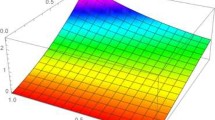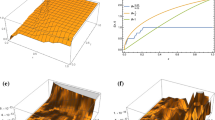The ideas of the method of fictitious domains and homotopy are combined with an aim to reduce the solution of boundary-value problems for multidimensional partial differential equations (PDE) in domains of any shape to an exponentially convergent sequence of PDE in a parallelepiped (or, in the 2D case, in a rectangle). This enables us to decrease the required computer time due to the elimination of the necessity of triangulation of the domain by a grid with N inner nodes (thus, the Delaunay algorithm in the 2D case requires \( \mathcal{O} \)(N log N) operations).
Similar content being viewed by others
References
P. N. Vabishchevich, Method of Fictitious Domains in the Problems of Mathematical Physics [in Russian], Moscow University, Moscow (1991).
V. K. Saul’ev, “On the solution of some boundary-value problems on high-speed computers by the method of fictitious domains,” Sib. Mat. Zh., 4, No. 1, 912–925 (1963).
G. I. Marchuk, Methods of Computational Mathematics [in Russian], Moscow, Nauka (1989).
V. D. Kopchenov, “Approximation of the solution of the Dirichlet problem by the method of fictitious domains,” Differents. Uravn., 4, No. 1, 151–164 (1968).
V. D. Kopchenov, “Method of fictitious domains for the second and third boundary-value problems,” Tr. Mat. Inst. Akad. Nauk SSSR, 131, 119–127 (1974).
V. I. Lebedev, “Difference analogs of the orthogonal decompositions of main differential operators and some boundary-value problems of mathematical physics,” Zh. Vychisl. Mat. Mat. Fiz., 4, No. 3, 449–465 (1964).
A. N. Konovalov, “Method of fictitious domains in the problems of torsion,” in: Numerical Methods of Mechanics of Continua [in Russian], 4, No. 2 (1973) pp. 109–115.
K. Yu. Bogachev, “Substantiation of the method of fictitious domains for the solution of mixed boundary-value problems for quasilinear elliptic equations,” Vestn. Mosk. Univ., Ser. 1, No. 3, 16–23 (1996).
L. A. Rukhovets, “Remarks on the method of fictitious domains,” Differents. Uravn., 3, No. 4, 698–701 (1967).
S. A. Voitsekhovskii, I. P. Gavrilyuk, and V. L. Makarov, “Convergence of difference solutions to generalized solutions of the Dirichlet problem for the Helmholtz equation in an arbitrary domain,” Dokl. Akad. Nauk SSSR, 267, No. 1, 34–37 (1982).
R. Glowinski, T.W. Pan, and J. Periaux, “A fictitious domain method for Dirichlet problem and applications,” Comput. Methods Appl. Mech. Eng., 111, No. 3-4, 283–303 (1994).
G. M. Kobel’kov, “Fictitious domain method and the solution of elliptic equations with highly varying coefficients,” Rus. J. Numer. Anal. Math. Modeling, 2, Issue 6, 407–420 (1987).
M. B. Brusnikin, “Of the efficient algorithms for the solution of problems by the method of fictitious domains in the multiply connected case,” Dokl. Ros. Akad. Nauk, 387, No. 2, 151–155 (2002).
N. S. Bakhvalov, K. Yu. Bogachev, and Zh. F. Métr, “An efficient algorithm for the solution of rigid elliptic problems with applications to the method of fictitious domains,” Zh. Vychisl. Mat. Mat. Fiz., 39, No. 6, 919–931 (1999).
V. L. Makarov, “On the functional-difference method of any order of accuracy for the solution of the Sturm–Liouville problem with piecewise smooth coefficients,” Dokl. Akad. Nauk SSSR, 320, No. 1, 34–39 (1991).
B. I. Bandyrs’kyi, V. L. Makarov, and O. L. Ukhan’ov, “FD-method for the Sturm–Liouville problem. Exponential rate of convergence,” Zh. Obchyslyuv. Prykl. Mat., 39, No. 1(85), 1–60 (2000).
E. M. Reingold, Combinatorial Algorithms. Theory and Practice, Prentice-Hall, New Jersey (1977).
Author information
Authors and Affiliations
Corresponding author
Additional information
Translated from Ukrains’kyi Matematychnyi Zhurnal, Vol. 72, No. 2, pp. 191–208, February, 2020.
Rights and permissions
About this article
Cite this article
Gavrilyuk, I.P., Makarov, V.L. Method of Fictitious Domains and Homotopy as a New Alternative to Multidimensional Partial Differential Equations in Domains of Any Shape. Ukr Math J 72, 211–231 (2020). https://doi.org/10.1007/s11253-020-01777-y
Received:
Published:
Issue Date:
DOI: https://doi.org/10.1007/s11253-020-01777-y




